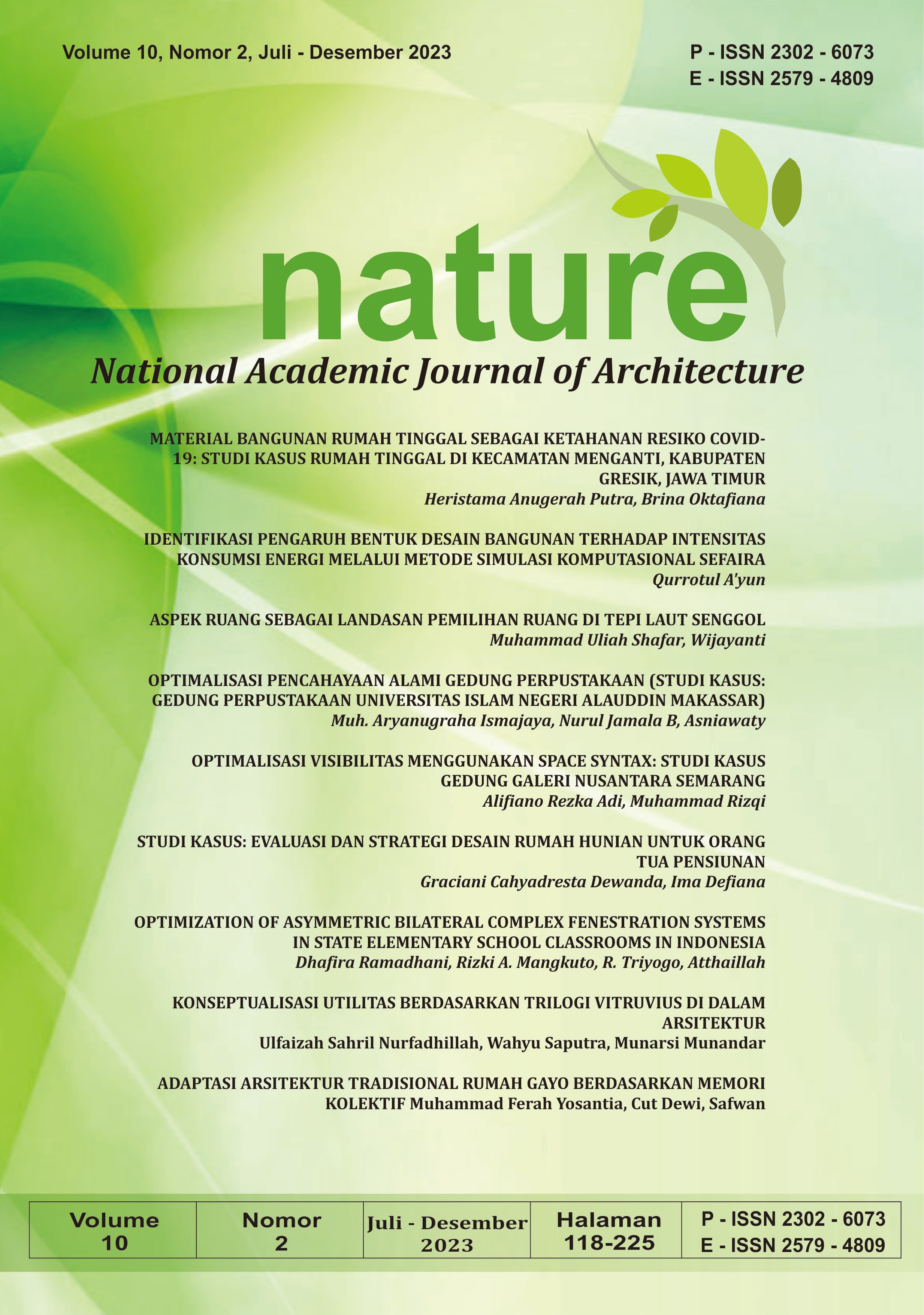ASPEK RUANG SEBAGAI LANDASAN PEMILIHAN RUANG DI TEPI LAUT SENGGOL
Abstract
The increasing of people’s demand on waterfront public space has motivated the waterfront concept that meet the visitor needs. One way to know public space design has met visitor needs is from understanding the preference on public space. Because of those demands, few spaces have emerged in Parepare, one of them is Senggol Beach. Waterfront public space has developed into two distinct spaces. This distinction create a contrast condition which enables people to pick one of the space between them. The huge difference in visitor number potentially creates unbalance to both of spaces. Therefore, Senggol Beach would not be optimal. In this case, public space clearly require the understanding of visitor needs through understanding of their preference. The purpose of this study is to analyze the space aspect which underlying the choice of space in the waterfront. This research method is mixed-method. While, this research design is cross-sectional using cross tabulation and biplot image analysis. Through questionnaire survey, respondents which consist of 85 people were asked to choose one of the spaces which they liked, including their reason to like it according to space aspects. The result shows that 66% respondents like A space and 35% like B space. The reason of many respondents is regarding facilities aspect. Therefore, available designs in B space does not satisfy most respondent’s preference.
Downloads
References
Ainy, C. (2016). Landscape Design for Sustainable Waterfront Community. JAILCD, 6.
Alves, S., Aspinall, P. A., Thompson, C. W., Sugiyama, T., Brice, R., and Vickers, A. (2008). Preferences of older people for environmental attributes of local parks. Facilities.
Amanda, T. A. (2020). Strategi Pengembangan Pariwisata Di Kota Parepare oleh Dinas Olahraga Pemuda dan Pariwisata Kota Parepare (unpublished doctoral dissertation). Universitas Hasanuddin.
Andi, Y., Trisutomo, S., dan Ali, M. (2017, October). Model Reklamasi Pantai Secara Berkelanjutan Kasus: Pantai Kota Makassar. TATALOKA, 19(4), 339. https://doi.org/10.14710/tataloka.19.4.339-354.
Carmona, M., Heath, T., Oc, T., and Tiesdell, S. (2003). Public Space–Urban Space, the Dimension of Urban Design. Edisi, 2, 114.
Carr, S., Stephen, C., Francis, M., Rivlin, L. G., and Stone, A. M. (1992). Public space. Cambridge University Press.
Creswell, J. W., and Poth, C. N. (2016). Qualitative Inquiry and Research Design: Choosing Among Five Approaches. Sage publications.
Davidowich, D. M. (1998). Assessment of recreation space along the Hudson River Waterfront in Jersey City, NJ (Department of Humanities and Social Sciences). New Jersey Institute of Technology, New Jersey.
Devy Sandra. (2012). Preferensi Masyarakat Terhadap Ketersediaan Taman Kota di Kota Pekanbaru-Propinsi Riau (Unpublished Doctoral Dissertation). Sekolah Pascasarjana Institut Pertanian Bogor, Bogor.
Dwiputra, I. D., dan Ardiani, N. A. (2017). Preferensi Masyarakat dalam Memilih Karakteristik Taman Kota Berdasarkan Motivasi Kegiatan. Prosiding Temu Ilmiah IPLBI, 6, 061–066.
Eldeeb, S. S., Galil, R. A., and Sarhan, A. E. (2015). A sustainability assessment framework for waterfront communities. Renewable Energy and Sustainable Development, 1(1), 167–183.
FHUH, and Aspan, Z. (2017, April). Tinjauan Yuridis Izin Reklamasi Pantai Makassar Dalam Mega Proyek Center Point of Indonesia. Bina Hukum Lingkungan, 1(2), 172–189. Doi: 10.24970/jbhl.v1n2.14
Grilli, G., Mohan, G., and Curtis, J. (2020). Public park attributes, park visits, and associated health status. Landscape and urban planning, 199, 103814.
Hoyle, B. (2001). Lamu: Waterfront Revitalization in an East African Port-City. Cities (London, England), 18(5), 297–313.
Hradilová, I., et al. (2013). Influence of Urban Waterfront Appearance on Public Space Functions. Acta Universitatis Agriculturae et Silviculturae Mendelianae Brunensis, 60(8), 261–268.
Hussein, R. (2014). Sustainable Urban Waterfronts Using the Sustainability Assessment Rating System. International Journal of Architectural and Environmental Engineering, 8(4), 488–498.
Kim, H. J. (2012). Researching Indoor Public Space Attributes: Enhancing the Interaction between Older Adults and Children (unpublished doctoral dissertation). North Carolina State University, Ann Arbor.
Knox, P., and Pinch, S. (2014). Urban social geography: an introduction. Routledge.
La Rosa, D., Takatori, C., Shimizu, H., and Privitera, R. (2018). A Planning Framework to Evaluate Demands and Preferences by Different Social Groups for Accessibility to Urban Greenspaces. Sustainable Cities and Society, 36, 346–362. Doi: 10.1016/j.scs.2017.10.026
Madureira, H., Nunes, F., Oliveira, J., and Madureira, T. (2018, February). Preferences for Urban Green Space Characteristics: A Comparative Study in Three Portuguese Cities. Environments, 5(2), 23. Doi: 10.3390/environments5020023
Mumcu, S., and Yilmaz, S. (2016). Seating furniture in open spaces and their contribution to social life. Environmental Sustainability and Landscape Management, 169.
Pramesti, R. E. (2017). Sustainable Urban Waterfront Redevelopment: Challenges and Key Issues. Jurnal Arsitektur dan Perencanaan Kota, 14, 14.
Puspitasari, R. A., Setioko, B., dan Pandelaki, E. E. (2015). Persepsi Integrasi Tata Guna Lahan pada Kawasan Waterfront Development (Studi Kasus: Kanal Banjir Barat Semarang). Teknik, 36(1), 17–23.
Shamsuddin, S., Abdul Latip, N. S., Ujang, N., Sulaiman, A. B., and Alias, N. A. (2013). How a city lost its waterfront: Tracing the Effects of Policies on the Sustainability of the Kuala Lumpur Waterfront as a Public Place. Journal of Environmental Planning and Management, 56(3), 378–397.
Tungka, A. E., Omran, A. A., Gebril, A. O., Wah, W. S., and Suprapti, A. B. (2012). Manado Waterfront Development Concept as a Sustainable City of Tourism. Bulletin of Engineering, 6.
Yassin, A. B. M., Eves, C., and McDonagh, J. (2010). An Evolution of Waterfront Development in Malaysia. In Proceedings of the 16th Annual Conference of the Pacific Rim Real Estate Society, Wellington, New Zealand (pp. 24–27).
Zhang, Y. (2006). A Landscape Preference Study of Campus Open Space. Mississippi State University.
Copyright (c) 2023 Muhammad Uliah Shafar, Wijayanti

This work is licensed under a Creative Commons Attribution-ShareAlike 4.0 International License.
By submitting your manuscript to our journal, you are following Copyright and License











